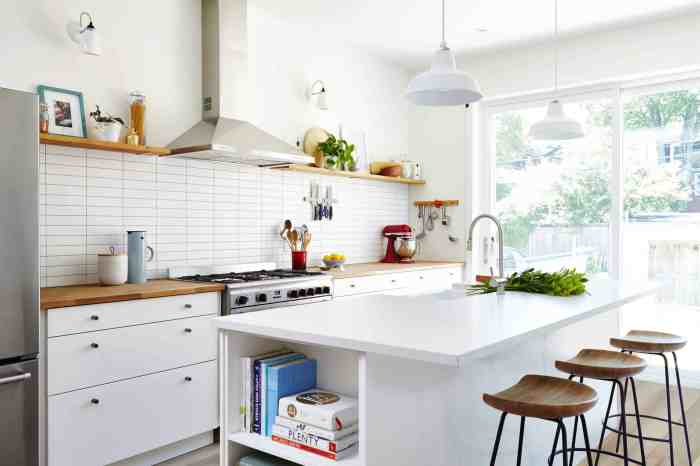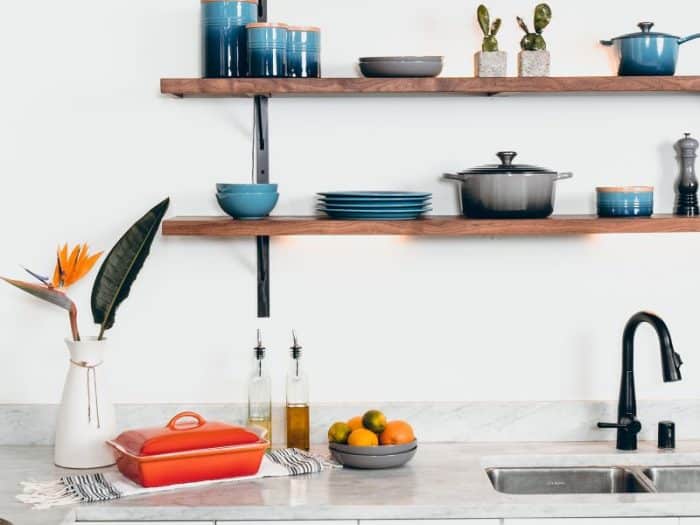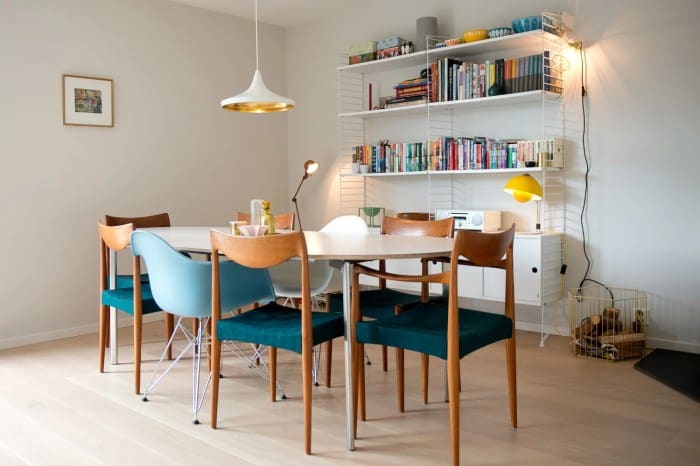The hallmark of Scandinavian design—its clean lines, functional minimalism, and inherent sense of calm—extends beautifully to the kitchen. More than just an aesthetic choice, this organizational philosophy hinges on a scientific understanding of human behavior and space optimization. By decluttering strategically and employing smart storage solutions, Scandinavian kitchens prioritize efficiency, minimizing wasted time and maximizing usable space. This approach isn’t about mere tidiness; it’s about creating a space that fosters well-being and enhances daily life, a space where every item has a purpose and a place.
This exploration delves into the core principles of Scandinavian kitchen organization, revealing the practical strategies and design elements that transform a chaotic culinary zone into a haven of efficiency and understated elegance. We’ll uncover the science behind minimalist living, explore space-saving techniques rooted in functionality, and examine how vertical space maximization contributes to an overall sense of order and serenity.
The result? A kitchen that’s not only beautiful but also profoundly practical, reflecting the balance between form and function that defines Scandinavian design.
Decluttering and Minimalism in Scandinavian Kitchens

The Scandinavian approach to kitchen organization prioritizes functionality, simplicity, and a sense of calm. This philosophy, often referred to as “lagom” (meaning “just the right amount”), directly influences decluttering practices, resulting in kitchens that are both aesthetically pleasing and highly efficient. The core principle is to eliminate unnecessary items, retaining only those that serve a clear purpose and contribute to a feeling of well-being.
Common Decluttering Methods in Scandinavian Homes
Scandinavian decluttering isn’t about a quick purge; it’s a mindful process. Common methods involve a systematic approach, often employing the KonMari method (though adapted to the Scandinavian aesthetic) or similar techniques focused on keeping only items that “spark joy.” This involves holding each item and assessing its usefulness and emotional resonance. Items are then categorized – often by type, not by location – allowing for a comprehensive evaluation of what’s truly needed.
The focus is on quality over quantity, favoring durable, well-made items that serve their purpose effectively. Regular audits, even on a monthly basis, help maintain this minimalist state.
Smart Storage Solutions for Scandinavian Kitchens

Scandinavian kitchen design prioritizes functionality and minimalism, seamlessly integrating storage solutions to maximize space and maintain a clean aesthetic. This approach leverages principles of ergonomics and visual harmony, resulting in kitchens that are both beautiful and highly efficient. The clever use of storage is not merely decorative; it’s a fundamental element of the overall design philosophy.
Open Shelving in Scandinavian Kitchens
Open shelving, a hallmark of Scandinavian design, offers several advantages. Firstly, it visually expands the space, creating a sense of openness and airiness, particularly beneficial in smaller kitchens. Secondly, it allows for easy access to frequently used items, reducing time spent searching and improving workflow efficiency. The visual appeal of open shelving also lies in its ability to showcase beautiful dishware and kitchen accessories, transforming utilitarian items into decorative elements.
However, successful implementation requires careful curation; only the most aesthetically pleasing and frequently used items should be displayed, maintaining a sense of order and preventing clutter. This strategic approach transforms open shelving from a potential source of visual chaos into a stylish and functional focal point. The psychological impact is significant, promoting a sense of calm and order, aligning with the core principles of Scandinavian design.
Space-Saving Storage Solutions in Scandinavian Kitchens
The following table details common space-saving storage solutions frequently found in Scandinavian kitchens:
| Item | Description | Material | Space Saving Benefit |
|---|---|---|---|
| Pull-out drawers | Drawers that extend fully, providing easy access to all contents. | Wood, metal | Maximizes use of cabinet space, eliminating the need to reach into deep cabinets. |
| Corner carousels | Rotating shelves that utilize otherwise inaccessible corner space. | Wood, metal | Transforms unusable corner space into efficient storage. |
| Vertical dividers | Dividers used within drawers or shelves to separate items and prevent stacking. | Wood, plastic, metal | Increases drawer/shelf capacity and organization, preventing items from being lost or crushed. |
| Slimline shelves | Narrow shelves designed to fit into tight spaces. | Wood, metal | Increases storage capacity in narrow cabinets or pantries. |
Baskets and Containers for Scandinavian Kitchen Organization
Baskets and containers are essential for maintaining order and a minimalist aesthetic in Scandinavian kitchens. Their use is not merely about hiding clutter; it’s about creating visual harmony and enhancing functionality. Natural materials like woven baskets, often made from rattan or willow, add texture and warmth, complementing the clean lines of Scandinavian design. Clear containers, on the other hand, allow for easy identification of contents, promoting efficiency.
The strategic use of baskets and containers helps to contain items, preventing them from becoming visually overwhelming. Consistent sizing and material choices contribute to a unified and cohesive look, enhancing the overall aesthetic appeal.
Pantry Drawer Organization in Scandinavian Kitchens
Efficient pantry organization is crucial in a Scandinavian kitchen. Items should be stored in a logical manner, prioritizing frequently used items for easy access. A typical Scandinavian pantry drawer might contain the following, organized for optimal efficiency:
- Baking supplies (flour, sugar, baking powder) in airtight containers.
- Cereal and grains in stackable containers.
- Pasta and rice in clear containers for easy identification.
- Snacks and treats in designated containers.
- Spices in a spice rack or organized alphabetically within a drawer.
This system maximizes space and ensures easy retrieval of items, minimizing time spent searching. The emphasis is on functionality and a visually appealing organization system that reflects the minimalist aesthetic of Scandinavian design.
Utilizing Vertical Space in Scandinavian Kitchens

Scandinavian design prioritizes functionality and minimalism, often within smaller spaces. Therefore, maximizing vertical space is crucial for achieving an efficient and aesthetically pleasing kitchen. This approach not only increases storage capacity but also contributes to the clean, uncluttered aesthetic characteristic of Scandinavian interiors. Effective use of vertical space allows for a streamlined kitchen that feels both spacious and organized.Wall-mounted shelving and cabinets are fundamental to this strategy.
They provide ample storage without encroaching on valuable floor space, a key principle of Scandinavian design. The strategic placement of these units allows for the efficient storage of frequently used items, reducing unnecessary movement and maximizing workflow efficiency. This aligns with the ergonomic principles often incorporated into Scandinavian design, emphasizing practicality and ease of use.
Wall-Mounted Shelving and Cabinetry Design Considerations
Careful consideration of design elements is paramount to successfully integrating wall-mounted storage without compromising the overall aesthetic. The choice of materials is crucial; light-colored woods such as birch or ash, or matte white or light grey finishes, are common choices that reflect light and maintain the airy feel of a Scandinavian kitchen. Open shelving, often combined with closed cabinets, creates a balance between visual accessibility and organized storage.
The depth of shelves and cabinets should be carefully planned to avoid creating a cluttered or overwhelming appearance; shallower units are often preferred to maintain a sense of openness. Uniformity in design elements, such as handle styles and shelf spacing, contributes to a cohesive and visually appealing result. Furthermore, the placement of these units should consider the workflow and proximity to appliances and work surfaces, optimizing functionality.
Creative Vertical Storage Solutions for Pots, Pans, and Utensils
Several creative solutions maximize vertical space while maintaining the Scandinavian aesthetic. For example, narrow, tall pull-out drawers can be installed to hold pots and pans, maximizing accessibility while keeping them neatly organized and hidden from view. Wall-mounted pot racks, made from sleek metal or wood, can add a touch of visual interest while providing convenient storage. Utensils can be stored in slim, vertical organizers that can be mounted on the inside of cabinet doors or on walls.
Magnetic strips, attached to the underside of upper cabinets, can efficiently store knives and other magnetic utensils, keeping them readily accessible and visually appealing. These storage solutions are not only functional but also contribute to the overall clean lines and minimalist look of a Scandinavian kitchen.
Visual Description of a Scandinavian Kitchen Utilizing Vertical Space
Imagine a kitchen bathed in soft, natural light. The walls are painted a muted grey-blue, complementing the light oak cabinetry. Tall, narrow cabinets stretch to the ceiling, their clean lines unbroken by excessive ornamentation. Open shelving, crafted from the same light oak, displays a carefully curated collection of white ceramic dishes and a few carefully chosen decorative items.
A sleek, stainless-steel pot rack hangs elegantly from the ceiling, holding a collection of copper and stainless-steel pots and pans. Underneath, a long, slender island provides additional counter space and storage. The overall effect is one of calm, functionality, and understated elegance – a testament to the successful integration of vertical space in a Scandinavian kitchen design.
The use of natural materials, light colors, and simple lines creates a sense of spaciousness despite the efficient use of vertical storage. The kitchen feels both functional and inviting, reflecting the core principles of Scandinavian design.
Maintaining Order and Cleanliness in a Scandinavian Kitchen
The hallmark of a Scandinavian kitchen is its functionality and uncluttered aesthetic. Maintaining this pristine environment requires a mindful approach to daily routines, strategic cleaning tools, and proactive clutter prevention. The principles of hygiene and efficiency underpin this process, ensuring a kitchen that is both beautiful and conducive to healthy living.
Daily Cleaning Routines
A consistent daily routine is crucial for preventing dirt and grime from accumulating. The key is to address small messes immediately, minimizing the time needed for larger cleaning sessions later. This approach is supported by behavioral science research demonstrating that small, consistent actions are more effective than infrequent, large-scale efforts in maintaining order. For instance, wiping down countertops after each use prevents spills from hardening and requiring more extensive scrubbing.
Similarly, washing dishes immediately after meals prevents the build-up of food residue and bacteria. A quick sweep of the floor after meal preparation eliminates crumbs and debris, preventing them from becoming embedded in flooring. This systematic approach transforms cleaning from a chore into a seamless part of the cooking process.
Essential Cleaning Tools and Supplies
A well-stocked cleaning caddy with efficient tools is essential for maintaining a Scandinavian kitchen’s cleanliness. The minimalist aesthetic of Scandinavian design translates to a focus on quality over quantity. A selection of microfiber cloths (known for their superior cleaning capabilities and sustainability), a natural bristle brush (for gentle yet effective scrubbing), a non-abrasive sponge, and a good quality all-purpose cleaner are sufficient for most daily tasks.
A dedicated cleaning spray bottle filled with a diluted white vinegar solution (a natural and effective disinfectant) can be used for routine surface cleaning. Investing in a high-quality stainless steel sink strainer prevents food particles from clogging drains and reduces the need for frequent drain cleaning.
Strategies for Preventing Clutter Build-Up
Preventing clutter is as important as cleaning it up. The core principle is to establish a system that promotes a continuous flow of items – in and out. Regularly decluttering countertops and shelves, using storage solutions that maximize space and keep items organized, and establishing a “one in, one out” rule for kitchenware are effective strategies. For example, when purchasing a new utensil, consider donating or discarding an old one.
This system prevents unnecessary accumulation of items and keeps the kitchen organized. Furthermore, designating specific storage locations for every item helps in maintaining order. This is aligned with organizational psychology principles suggesting that defined spaces improve efficiency and reduce stress associated with searching for items.
Weekly Cleaning Schedule
A weekly cleaning schedule optimizes cleaning efficiency. This schedule focuses on deeper cleaning tasks not addressed daily, ensuring a consistently clean and hygienic kitchen.
- Monday: Clean the refrigerator (removing expired items and wiping shelves).
- Tuesday: Clean the microwave and oven (removing food splatters and crumbs).
- Wednesday: Clean countertops and sink thoroughly.
- Thursday: Sweep or vacuum the floor.
- Friday: Clean small appliances (toaster, blender, etc.).
- Saturday: Deep clean one area, such as the pantry or cabinets.
- Sunday: Rest and enjoy your clean and organized kitchen!
This schedule can be adjusted to fit individual needs and preferences, but the principle of spreading out tasks throughout the week ensures that no single day is overburdened with cleaning.
The Role of Functionality and Aesthetics in Scandinavian Kitchen Organization
The Scandinavian design philosophy, renowned for its minimalist aesthetic, seamlessly integrates functionality and beauty in kitchen design. This approach isn’t merely a stylistic choice; it’s a reflection of a cultural emphasis on practicality and well-being, informed by the region’s long history of resourcefulness and connection with nature. The interplay between these two elements – functionality and aesthetics – is crucial to achieving the signature clean, calming, and efficient Scandinavian kitchen.
Scandinavian kitchen design prioritizes both functionality and aesthetics, but the balance between them is nuanced. While functionality underpins the overall design, ensuring efficient workflow and ease of use, aesthetics elevate the space into a haven of calm and style. This is achieved not through ornamentation, but through careful selection of materials, color palettes, and a focus on natural light.
The key is to create a space that is both highly practical and visually appealing, reflecting a harmonious blend of form and function.
Key Design Elements Contributing to Functionality and Aesthetic Appeal
The inherent functionality of a Scandinavian kitchen is often achieved through smart storage solutions, such as built-in shelving and drawers that maximize space utilization. The aesthetic appeal, meanwhile, is derived from the use of natural materials like light wood, often birch or pine, and the incorporation of natural light. These materials, chosen for both their durability and beauty, create a warm and inviting atmosphere.
The minimalist approach, characterized by clean lines and a lack of clutter, further enhances the aesthetic appeal by creating a sense of spaciousness and tranquility. Consider the clean lines of a simple, wooden countertop paired with sleek, stainless steel appliances; this exemplifies the balanced approach to form and function. The functionality is evident in the easy-to-clean surfaces and efficient layout, while the aesthetic is achieved through the natural warmth of the wood and the modern elegance of the steel.
Functionality Enhancing the Overall Aesthetic of a Scandinavian Kitchen
Functionality, far from being a constraint, actually enhances the aesthetic appeal of a Scandinavian kitchen. Efficient storage solutions, for instance, contribute directly to the minimalist aesthetic by keeping surfaces clear and clutter-free. A well-organized kitchen, where everything has its designated place, appears visually calming and uncluttered. The seamless integration of appliances and storage solutions into the overall design, rather than appearing as separate elements, contributes to a unified and aesthetically pleasing space.
For example, built-in appliances blend seamlessly into the cabinetry, maintaining the clean lines and minimizing visual distractions. This approach reflects the Scandinavian principle of “hygge,” creating a comfortable and inviting atmosphere.
Balancing Form and Function in a Scandinavian Kitchen
Balancing form and function requires careful consideration of every element within the kitchen. For example, choosing durable, easy-to-clean materials like quartz or laminate countertops provides functionality while maintaining a sleek, modern aesthetic. Similarly, opting for minimalist, handleless cabinetry maximizes storage space while maintaining a clean, uncluttered look. The strategic use of lighting, such as pendant lights above an island or under-cabinet lighting, provides both functional illumination and a visually appealing focal point.
Consider a kitchen with white walls, light wood cabinets, and a single, statement pendant light over a kitchen island. The white walls and light wood create a bright and airy atmosphere, while the pendant light adds a touch of elegance and functionality, providing focused light for food preparation. This simple design achieves both practicality and visual appeal, reflecting the core principles of Scandinavian design.
Final Wrap-Up

Ultimately, achieving a truly organized Scandinavian kitchen transcends mere aesthetics; it’s about cultivating a mindful approach to daily living. By embracing the principles of minimalism, maximizing vertical space, and implementing smart storage solutions, you’re not just organizing your kitchen—you’re creating a space that promotes calm, efficiency, and a deeper connection to your culinary practices. The journey towards a functional and aesthetically pleasing Scandinavian kitchen is a testament to the power of intentionality and the transformative effect of mindful organization.
The result is a space that is both visually stunning and incredibly practical, reflecting the core tenets of Scandinavian design philosophy.
FAQs
What are some common misconceptions about Scandinavian kitchen design?
A common misconception is that Scandinavian kitchens are stark and cold. While minimalism is key, the use of natural light, warm woods, and textiles creates a cozy and inviting atmosphere. Another is that it’s expensive; many budget-friendly solutions exist to achieve a similar aesthetic.
How do I incorporate sustainable practices into my Scandinavian kitchen organization?
Choose eco-friendly cleaning products, utilize reusable containers and cloths, and opt for sustainable materials like bamboo or recycled wood for storage solutions. Prioritize reducing waste through mindful consumption and composting.
Can I adapt Scandinavian organization principles to a smaller kitchen?
Absolutely! Scandinavian principles, focused on minimalism and efficient storage, are particularly beneficial in smaller spaces. Prioritize multi-functional furniture and vertical storage to maximize limited square footage.
How often should I declutter my Scandinavian kitchen?
Regular decluttering is crucial. A quick tidy-up daily prevents clutter buildup, while a more thorough declutter of specific areas (e.g., a drawer or shelf) should be done weekly or monthly, depending on usage.